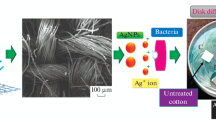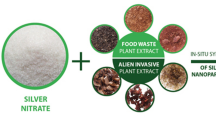Abstract
Antibacterial and UV-protective cotton fabrics were produced with an in-situ synthesis of silver nanoparticles using trisodium citrate as reductive agent and microwave irradiation for starting the synthesis reaction. The creation of silver nanoparticles with different morphologies such as quasi-spherical and cubic nanoparticles was confirmed by the SEM images. The EDS pattern of the loaded sample confirmed the uniform silver loading on the surface of cotton fibers as well as their crystal structure was approved by the X-ray diffraction pattern. Increasing reaction temperature (80, 100, 120, and 140 °C) caused a significant decrease up to 75% in the average diameter of nanoparticles and narrowing the size distribution. Also, increasing amounts of trisodium citrate (0, 100, 200, and 400 ppm) in the synthesizing solution resulted in a decrease up to of 59% in the average diameter and prevented agglomeration of nanoparticles. The FTIR spectra confirmed that the highest absorbed water in the loaded cotton samples was achieved in the highest concentration of trisodium citrate. The antibacterial properties of loaded cotton samples significantly depended on the reaction temperature as well as trisodium citrate concentration. The loaded cotton fabrics showed active antibacterial properties with inhibition zones of 16–18.5 mm against the Gram-positive Staphylococcus aureus and the Gram-negative Escherichia coli. Moreover, the prepared AgNP cotton fabrics demonstrated excellent UV-rays blocking properties with a high rate of ultraviolet protection factor value.
Graphic abstract












Similar content being viewed by others
References
Aboutorabi SN, Nasiriboroumand M, Mohammadi P et al (2018) Biosynthesis of silver nanoparticles using safflower flower: structural characterization, and its antibacterial activity on applied wool fabric. J Inorg Organomet Polym Mater 28:2525–2532. https://doi.org/10.1007/s10904-018-0925-5
Aboutorabi SN, Nasiriboroumand M, Mohammadi P et al (2019) Preparation of antibacterial cotton wound dressing by green synthesis silver nanoparticles using mullein leaves extract. J Renew Mater 7:787–794. https://doi.org/10.32604/jrm.2019.06438
Adeel S, Naseerjaved K, S et al (2018) Microwave-assisted improvement in dyeing behavior of chemical and bio-mordanted silk fabric using safflower (Carthamus tinctorius L) extract. J Nat Fibers 17:55–65. https://doi.org/10.1080/15440478.2018.1465877
Aswathy B, Avadhani GS, Sumithra IS et al (2011) Microwave assisted synthesis and UV–Vis spectroscopic studies of silver nanoparticles synthesized using vanillin as a reducing agent. J Mol Liq 159:165–169. https://doi.org/10.1016/j.molliq.2011.01.001
Barani H (2014) Surface activation of cotton fiber by seeding silver nanoparticles and in situ synthesizing ZnO nanoparticles. New J Chem 38:4365. https://doi.org/10.1039/C4NJ00547C
Barani H, Haji A (2015) Analysis of structural transformation in wool fiber resulting from oxygen plasma treatment using vibrational spectroscopy. J Mol Struct 1079:35–40. https://doi.org/10.1016/j.molstruc.2014.09.041
Barani H, Montazer M, Samadi N et al (2014) Application of nano silver/lecithin on wool through various methods: antibacterial properties and cell toxicity. J Eng Fiber Fabr 9:126–134. https://doi.org/10.1177/155892501400900415
Barani H, Montazer M, Samadi N, Toliyat T (2012) In situ synthesis of nano silver/lecithin on wool: enhancing nanoparticles diffusion. Colloids Surf B Biointerfaces 92:9–15. https://doi.org/10.1016/j.colsurfb.2011.10.062
Barani H, Montazer M, Toliyat T, Samadi N (2010) Synthesis of Ag-liposome nano composites. J Liposome Res 20:323–329. https://doi.org/10.3109/08982100903544177
Bartosewicz B, Bujno K, Liszewska M, Budner B, Bazarnik P, Płociński T, Jankiewicza BJ (2018) Effect of citrate substitution by various α-hydroxycarboxylate anions on properties of gold nanoparticles synthesized by Turkevich method. Coll Surf A Physicochem Eng Asp 549:25–33. https://doi.org/10.1016/j.colsurfa.2018.03.073
Bilecka I, Niederberger M (2010) Microwave chemistry for inorganic nanomaterials synthesis. Nanoscale 2:1358–1374. https://doi.org/10.1039/b9nr00377k
Dankovich TA (2014) Microwave-assisted incorporation of silver nanoparticles in paper for point-of-use water purification. Environ Sci Nano 1:367–378. https://doi.org/10.1039/c4en00067f
Djokic S (2008) Synthesis and antimicrobial activity of silver citrate complexes. Bioinorg Chem Appl 2008:436458. https://doi.org/10.1155/2008/436458
Dobnik P (2010) Woven fabric and ultraviolet protection. In: Woven fabric engineering, intechopen, London, pp 273–296.
El-Naggar ME, Shaheen TI, Zaghloul S et al (2016) Antibacterial activities and uv protection of the in situ synthesized titanium oxide nanoparticles on cotton fabrics. Ind Eng Chem Res 55:2661–2668. https://doi.org/10.1021/acs.iecr.5b04315
Emam HE (2019) Generic strategies for functionalization of cellulosic textiles with metal salts. Cellulose 26:1431–1447. https://doi.org/10.1007/s10570-018-2185-5
Gawande MB, Shelke SN, Zboril R, Varma RS (2014) Microwave-assisted chemistry: synthetic applications for rapid assembly of nanomaterials and organics. Acc Chem Res 47:1338–1348. https://doi.org/10.1021/ar400309b
Gorjanc M, Šala M (2016) Durable antibacterial and UV protective properties of cellulose fabric functionalized with Ag/TiO2 nanocomposite during dyeing with reactive dyes. Cellulose 23:2199–2209. https://doi.org/10.1007/s10570-016-0945-7
Haji A, Barani H, Qavamnia SS (2013a) In situ synthesis and loading of silver nanoparticles on cotton fabric. Ind Textila 64:8–12
Haji A, Barani H, Qavamnia SS (2013b) In situ synthesis of silver nanoparticles onto cotton fibres modified with plasma treatment and acrylic acid grafting. Micro Nano Lett 8:315–318. https://doi.org/10.1049/mnl.2013.0157
Hassabo AG, El-Naggar ME, Mohamed AL, Hebeish AA (2019) Development of multifunctional modified cotton fabric with tri-component nanoparticles of silver, copper and zinc oxide. Carbohydr Polym 210:144–156. https://doi.org/10.1016/J.CARBPOL.2019.01.066
Hong X, Wen J, Xiong X, Hu Y (2016) Shape effect on the antibacterial activity of silver nanoparticles synthesized via a microwave-assisted method. Environ Sci Pollut Res 23:4489–4497. https://doi.org/10.1007/s11356-015-5668-z
Horikoshi S, Abe H, Torigoe K et al (2010) Access to small size distributions of nanoparticles by microwave-assisted synthesis. formation of ag nanoparticles in aqueous carboxymethylcellulose solutions in batch and continuous-flow reactors. Nanoscale 2:1441–1447. https://doi.org/10.1039/c0nr00141d
Hu B, Wang SB, Wang K et al (2008) Microwave-assisted rapid facile “green” synthesis of uniform silver nanoparticles: self-assembly into multilayered films and their optical properties. J Phys Chem C 112:11169–11174. https://doi.org/10.1021/jp801267j
Ibrahim NA, Eid BM, Abdel-Aziz MS (2016) Effect of plasma superficial treatments on antibacterial functionalization and coloration of cellulosic fabrics. Appl Surf Sci 392:1126–1133. https://doi.org/10.1016/j.apsusc.2016.09.141
Jiang XC, Chen CY, Chen WM, Yu AB (2009) Role of citric acid in the formation of silver nanoplates through a synergistic reduction approach. Langmuir 26:4400–4408. https://doi.org/10.1021/la903470f
Kahrilas GA, Wally LM, Fredrick SJ et al (2014) Microwave-assisted green synthesis of silver nanoparticles using orange peel extract. ACS Sustain Chem Eng 2:367–376. https://doi.org/10.1021/sc4003664
Khan Z, Al-Thabaiti SA, Al-Nowaiser FM, Obaid AY, Al-Youbi AO, Malik MA (2012) Kinetics of silver nanoparticle growth in aqueous polymer solutions. Arab J Chem 5:453–459. https://doi.org/10.1016/j.arabjc.2010.12.024
Li S, Lin X, Liu Y et al (2019) Phosphorus-nitrogen-silicon-based assembly multilayer coating for the preparation of flame retardant and antimicrobial cotton fabric. Cellulose 26:4213–4223. https://doi.org/10.1007/s10570-019-02373-5
Mezni A, Ben SN, Bukhari A et al (2019) Plasmonic hybrid platinum-titania nanocomposites as highly active photocatalysts: self-cleaning of cotton fiber under solar light. J Mater Res Technol 9:1447–1456. https://doi.org/10.1016/j.jmrt.2019.11.070
Milošević M, Šaponjić Z, Nunney T et al (2017) In situ photoreduction of Ag+-ions on the surface of titania nanotubes deposited on cotton and cotton/PET fabrics. Cellulose 24:1597–1610. https://doi.org/10.1007/s10570-017-1207-z
Mishra A, Butola BS (2017) Deposition of Ag doped TiO2 on cotton fabric for wash durable UV protective and antibacterial properties at very low silver concentration. Cellulose 24:3555–3571. https://doi.org/10.1007/s10570-017-1352-4
Nthunya LN, Derese S, Gutierrez L et al (2019) Green synthesis of silver nanoparticles using one-pot and microwave-assisted methods and their subsequent embedment on PVDF nanofibre membranes for growth inhibition of mesophilic and thermophilic bacteria. New J Chem 43:4168–4180. https://doi.org/10.1039/C8NJ06160B
Peng L, Guo R, Lan J et al (2016a) Microwave-assisted deposition of silver nanoparticles on bamboo pulp fabric through dopamine functionalization. Appl Surf Sci 386:151–159. https://doi.org/10.1016/j.apsusc.2016.05.170
Peng L, Guo R, Lan J et al (2016b) Microwave-assisted coating of silver nanoparticles on bamboo rayon fabrics modified with poly (diallyldimethylammonium chloride). Cellulose 23:2677–2688. https://doi.org/10.1007/s10570-016-0931-0
Pillai ZS, Kamat PV (2004) What factors control the size and shape of silver nanoparticles in the citrate ion reduction method? J Phys Chem B 108:945–951. https://doi.org/10.1021/jp037018r
Popa M, Pradell T, Crespo D, Calderón-Moreno JM (2007) Stable silver colloidal dispersions using short chain polyethylene glycol. Colloids Surfaces A Physicochem Eng Asp 303:184–190. https://doi.org/10.1016/j.colsurfa.2007.03.050
Ranoszek-Soliwoda K, Tomaszewska E, Socha E et al (2017) The role of tannic acid and sodium citrate in the synthesis of silver nanoparticles. J Nanopart Res 19:273. https://doi.org/10.1007/s11051-017-3973-9
Rashid MU, Bhuiyan MKH, Quayum ME (2013) Synthesis of silver nano particles (Ag-NPs) and their uses for quantitative analysis of vitamin C tablets. Dhaka Univ J Pharm Sci 12:29–33. https://doi.org/10.3329/dujps.v12i1.16297
Shahid-Ul-Islam BBS, Mohammad F (2016) Silver nanomaterials as future colorants and potential antimicrobial agents for natural and synthetic textile materials. RSC Adv 6:44232–44247. https://doi.org/10.1039/C6RA05799C
Tsuji M, Gomi S, Maeda Y et al (2012) Rapid transformation from spherical nanoparticles, nanorods, cubes, or bipyramids to triangular prisms of silver with PVP, citrate, and H2O2. Langmuir 28:8845–8861. https://doi.org/10.1021/la3001027
Tuner H, Korkmaz M (2010) Effects of gamma radiation on solid trisodium citrate dihydrate: radical kinetics, radiosensitivity and dosimetry. Radiat Environ Biophys 49:723–729. https://doi.org/10.1007/s00411-010-0304-2
Wilson CA, Gies PH, Niven BE et al (2008) The relationship between uv transmittance and color– visual description and instrumental measurement. Text Res J 78:128–137. https://doi.org/10.1177/0040517507081302
Yasmin Z., Catala A, Maswadi S, Nash K L, Glickman R K (2016) In fabrication and self-assembly of nanobiomaterials, William Andrew, UK, pp 117–147. https://doi.org/10.1016/B978-0-323-41533-0.00005-2
Yu Z, He H, Liu J et al (2020) Simultaneous dyeing and deposition of silver nanoparticles on cotton fabric through in situ green synthesis with black rice extract. Cellulose 27:1829–1843. https://doi.org/10.1007/s10570-019-02910-2
Zhao X, Xia Y, Li Q et al (2014) Microwave-assisted synthesis of silver nanoparticles using sodium alginate and their antibacterial activity. Coll Surf A Physicochem Eng Asp 444:180–188. https://doi.org/10.1016/j.colsurfa.2013.12.008
Zhou Q, Lv J, Ren Y et al (2017) A green in situ synthesis of silver nanoparticles on cotton fabrics using Aloe vera leaf extraction for durable ultraviolet protection and antibacterial activity. Text Res J 87:2407–2419. https://doi.org/10.1177/0040517516671124
Zhu YJ, Chen F (2014) Microwave-assisted preparation of inorganic nanostructures in liquid phase. Chem Rev 114:6462–6555. https://doi.org/10.1021/cr400366s
Özyürek M, Güngör N, Baki S et al (2012) Development of a silver nanoparticle-based method for the antioxidant capacity measurement of polyphenols. Anal Chem 84:8052–8059. https://doi.org/10.1021/ac301925b
Acknowledgments
This study was supported by the University of Birjand, Iran and the Niederrhein University of Applied Sciences, Mönchengladbach, Germany, Faculty of Textile and Clothing Technology providing the research facilities. The authors also thank Dr. Mohsen Khorashadi Zadeh (Birjand University of Medical Sciences) for antibacterial assays.
Author information
Authors and Affiliations
Corresponding author
Ethics declarations
Conflict of interest
The authors declare that they have no conflict of interest.
Additional information
Publisher's Note
Springer Nature remains neutral with regard to jurisdictional claims in published maps and institutional affiliations.
Electronic supplementary material
Below is the link to the electronic supplementary material.
Rights and permissions
About this article
Cite this article
Barani, H., Mahltig, B. Using microwave irradiation to catalyze the in-situ manufacturing of silver nanoparticles on cotton fabric for antibacterial and UV-protective application. Cellulose 27, 9105–9121 (2020). https://doi.org/10.1007/s10570-020-03400-6
Received:
Accepted:
Published:
Issue Date:
DOI: https://doi.org/10.1007/s10570-020-03400-6




